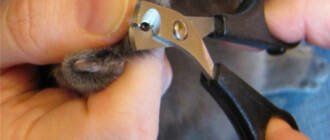Eye problems require consultation with a highly specialized specialist. That is why a veterinary ophthalmology clinic, equipped with modern, expensive machines for the diagnosis and treatment of eye diseases in animals, is recommended.

- Kitten's eye swelling: how to save the pet?
- Why are kitten's eyes swollen?
- Why is a cat's eye swollen?
- How to provide first aid
- Conjunctivitis in cats: symptoms and treatment
- Catarrhal form
- Purulent form
- Phlegmonic form.
- Follicular form
- Treatment of viral conjunctivitis in cats
- Eye irrigation
- Using eye ointment
- Drops
- Antibiotics
- Causes of lacrimation in cats and dogs
- How should the tear discharge be treated?
- What you need to pay attention to
- Most common diseases
- Trauma
- Causes and related symptoms
- Damage
- Keratitis in pets
- Third eyelid prolapse
- Eyelid puffiness
- How to treat?
- Twisted eyelid
- Internal pathologies that cause swelling
- Eye swelling in a cat as a symptom of a serious disease
- Eye swelling in a cat: what to do?
- What veterinary ophthalmology services to choose if your cat has puffy eyes
- Reviews of A.G. Shilkin Veterinary Ophthalmology Clinic
Kitten's eye swelling: how to save the pet?
Kittens often have problems with their eyes. Breeds that have large convex eyes that are not protected by eyelashes are most susceptible to this.
If you notice your kitten's mucosa or the eyeball itself reddening, profuse discharge from the eyes, contact an ophthalmology veterinarian. Eye swelling in kittens can be a symptom of many diseases, including contagious ones.
A consultation at a regular veterinary clinic will rarely yield a positive result. The general practitioner does not specialize in eye disease, and the clinics themselves do not have the expensive equipment that ophthalmology clinics do.
Why are kitten's eyes swollen?
In kittens, eye diseases are usually of infectious nature: rhinotracheitis, blepharitis, chlamydia, mycoplasmosis, etc. In kittens, the infection develops quickly, which can lead not only to the loss of an eye, but also to the death of the kitten.

Is your kitten's eye swollen? Everything is not as harmless as it may seem to the breeder at first glance. How do you know it's time to call an ophthalmologist? The following symptoms should alert you:
If you find one or more of these symptoms in your kitten, you need to show him to a specialist immediately.
Why is a cat's eye swollen?
Not all cat lovers know what to do if their pet has a swollen eye. Not long ago he was running, playing and pleasing others, and now he is sick. A cat is a member of family and is dear to the owners, so you have to be patient to cure him, he will appreciate it.
A cat's eye is swollen. Why is there festering and swelling of the eyes in cats, with the cheek and nose not in the best shape either? A third or white eye is a sign of infectious diseases. It is possible that it happened when the cat got into a fight defending its territory.
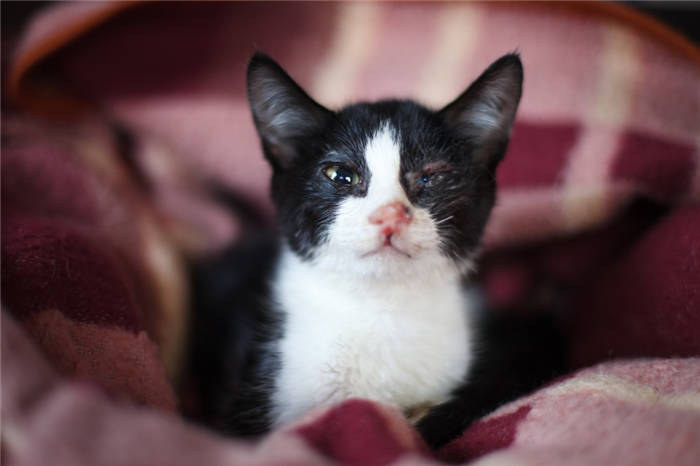
On the forum of animal lovers discuss this problem and confirm that everything has grounds and such in this case are:
- Injury. When the eye is swollen, this may be the cause of the bump. Accidental collision of the head with a hard object gives swelling. Of course, this is difficult to determine, since cats do not have bruises.
- Ingestion of a foreign body. The eye has begun to swell and pus is oozing from it and the swelling is hot. The object may be debris, sand or wood chips. The main thing is not to try to remove it yourself, but to see a specialist.
- Conjunctivitis, glaucoma or other pathology. The cause of a swollen eye can also be this kind of disease. It is not difficult to identify these manifestations: the pet cannot orientate itself in space and a slight touch to this place brings him pain. A visit to the veterinarian should not be delayed.
- Oncology. Strange as it may seem, neoplasms are also found in animals. The cat loses its vision, and as a result the coordination of movements in space is impaired. Examination by a specialist is mandatory in order to ascertain this factor.
- Blepharitis. The eyelid is inflamed and with a little pressure comes pain. But if you find hard tissue in the eyeball area, you should not delay going to a specialist.
- Eversion and twisting .. Kitten has swollen cheeks and swollen eyes, it may be due to eyelash curl. That is, the eyelashes get into the eye, and stick to the cornea. This begins to rub on the eyeball, a white film appears, and the eye begins to fester. On the contrary, with eversion, the circles of the eyelids begin to crack, resulting in swelling and inflammation.
- Abnormalities of the heart muscle and kidneys. Swollen eye and swollen cat's eye and it is not necessarily a consequence of external factors, but can also be a disease of internal organs. Due to their insufficient work, the development of swelling occurs.
How to provide first aid
In the cat's eyes swollen film and partly begin to tear, then in this case you can use simple means, such as hydrogen peroxide of low concentration, thick brew of tea or solution of furacilin.
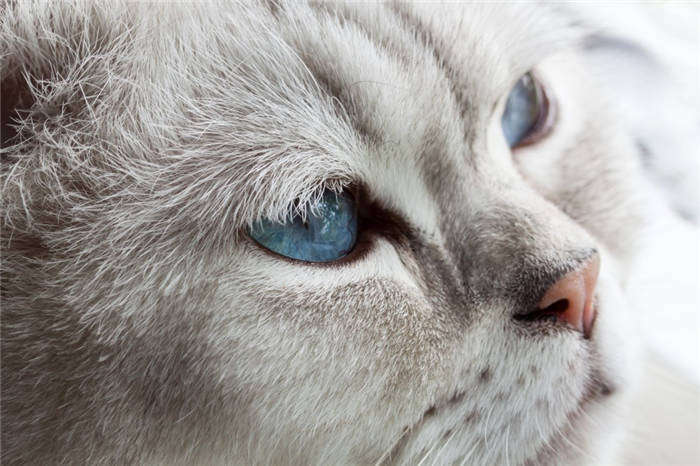
- After moistening a cotton pad with the product, you should gently sweep it around the eye, removing crusts from the corners toward the center. A little wiggling of the cotton swab near the eye will make the pet feel better.
- Tetracycline ointment will also help in the early stages of conjunctivitis.
- Furacilin solution also relieves primary inflammation, but rinsing the eye when it is swollen needs several times a day to achieve results.
- Chamomile decoctions also have a bactericidal effect, the main thing is that they should be at room temperature.
If after applying one of the methods, there is no improvement, the first thing to do is to show the cat to a specialist. Only with the proper care can you return health to your fluffy friend, and joy to see him in good spirits.
Conjunctivitis in cats: symptoms and treatment
Treatment of the disease is carried out after diagnosis and determination of the specific type of conjunctivitis in the veterinary clinic. The disease is indicated by:
Any inflammation of the mucous membrane of the eyelid begins as catarrhal conjunctivitis, which can progress to a more serious form of the pathology. To prevent this from happening, see your veterinarian right away to find out the source of the inflammation!
Catarrhal form
Least dangerous for the animal, but requires comprehensive treatment. The course is determined only by the veterinarian! If the proper measures are not taken, various complications are possible. Mucus (catarrh) is supplemented by purulent ocular discharge. If the animal has redness, swelling, everted eyelids, tearfulness, consult a specialist. To successfully treat the cat, it is important to stop the inflammation in time.
Purulent form
The beginning of the process can be evidenced by yellow crusts in the morning. The appearance of yellow or yellow-green pus, sticking eyelids already indicate the dangerous development of the disease. It could be an infection, and inflammation is a symptom. Do not allow even more serious complications.
Phlegmonic form.
There is a discharge of pus outside and into the subepithelial layer. Treatment is very difficult, even with the help of an experienced veterinarian.
Follicular form
The mucosa of the eyelid and the lymph follicles on the inside are inflamed. A bulge is observed. Follicular conjunctivitis requires long-term therapy and sometimes surgical removal of the follicles. Cats are then prescribed antibiotics and eye drops.

Treatment of viral conjunctivitis in cats
Important! Viral conjunctivitis in cats is diagnosed only in the conditions of the clinic. Treatment is carried out after an accurate diagnosis with the help of tests and medications.
Depending on the cause of the disease and its complexity, the veterinarian determines the optimal complex therapy.
Eye irrigation
Using eye ointment
Apply the ointment under the eyelid (only after rinsing the eye!), preferably with a special chopstick, having previously put it in boiling water.
Drops
A few drops for the treatment of conjunctivitis should be put in every few hours.
Antibiotics
Causes of lacrimation in cats and dogs
Profuse lacrimation can not be called the norm. This condition may be provoked by the following causes:
- The most common reason why a cat's eyes water is due to physical discomfort. It can be foreign bodies – dust, sand, plant seeds. There may be irritating substances – smoke, chemical solutions. If an animal has a foreign body in its eye, the normal physiological reaction will be an abundant secretion of tear fluid, which will flush the foreign body out of the eye. And once it is completely removed and there is no damage to the eye, the lacrimation will quickly stop. The goal has been achieved – the body has gotten rid of a foreign body, such as a speck of dust or a hair, that has entered the eye.
- Another reason why a dog's eyes are very watery may be a deformity or change in the condition of the lacrimal duct. This can occur as a result of a congenital pathology of the canal, or it can also occur after mechanical trauma to the eye. Inflammation may also be the reason why your dog's eyes are watery. When there is inflammation (conjunctivitis), there may even be a blockage of the lacrimal duct. This causes a large amount of tear fluid to be secreted. In this case, you will observe that the pet's eyes are red and the tears are cloudy and have a yellowish or greenish tint.
- If your dog's eyes are watery or your cat's eyes are watery and pusy, it is likely that your cat is developing an eye infection. In this case, you need to show your cat or dog to a veterinary specialist to find out why your pet's eyes are watering, what caused the inflammation, and how to treat it. Eye infections can cause irreversible consequences – the pet may go blind or lose the visual organs directly, so proper therapy should be started right away. And this, as we know, can only be done by an experienced veterinarian. Infections – the most common in cats are herpesvirus infection, chlamydia, toxoplasmosis. In dogs, infectious diseases rarely manifest with eye inflammation.
- Allergies. If you notice a cat sneezing and watery eyes, allergies are likely to be to blame. Take a closer look at your pet. You will probably notice how the cat tries to rub its eyes with its paw, exposing them to additional trauma. Remember, one of the main symptoms of allergies is that the cat's eyes are very watery and itchy in the eye area all the time.
- Anatomical defects are the most common in dogs. These include eversion and eversion of the eyelids and distichiasis (double rows of eyelashes). These abnormalities are usually specific to certain breeds of dogs, but can occur in any breed of dog. For example, tears often occur in the eyes of the Spitz, Toy Terrier, Poodle, Schnauzer, Shih Tzu and Yorkshire Terrier because they often have incorrectly growing eyelashes and hair in the eye area, causing constant discomfort and irritation. In cats, these ophthalmic disorders are much less common than in dogs, but it can happen too. When the eyelashes are wound up, respectively, they are in close contact with the cornea, scratching and "cutting" it. As a consequence, all the same inflammation and edema develop, and the organ is often severely pus-like. With eversion, the "insides" of the eyelid dry out, crack, and therefore become inflamed and swollen.
- Such a pathology as a violation of the outflow of tears, in most cases just occur in cats. As a result of this disorder tear fluid accumulates on the surface of the eye and overflows over the edge of the eyelid onto the muzzle. It appears as if the animal's eyes are leaking. This results in a dark staining of the coat and crusts around the eye due to the constant moisture. Normally, tears wash over the cornea and collect in the inner corner of the eye, where the lacrimal lake is located. From the lacrimal lake the tears flow through the lacrimal points into the lacrimal ducts, then into the lacrimal sac, and from there through the nasolacrimal duct into the nasal and oral cavities. When there is an obstruction to the outflow of the tears, lacrimation occurs. Obstacles can occur in any part of the lacrimal system, for example in the area of the lacrimal points; inflammation of the lacrimal sac (dacryocystitis); compression of the lacrimal ducts by a tumor or edema as a result of an injury.
How should the tear discharge be treated?
In order to help your pet it is not enough to go to the vet for a consultation and buy a suitable remedy. It is necessary to know how to use it correctly in order to help and not to harm your pet. Here is a list of simple but very effective rules:
- Wash your hands to avoid putting dirt and infection in your pet's eyes.
- Get saline or chlorhexidine. You don't want to use brews or unstrained herbal decoctions for this procedure, as the fine fraction can cause your pet even more problems, which in conjunctivitis and other illnesses is important to avoid. Gently use a cotton swab dipped in saline or warm water to clean the coat around the eyes and in the eyelid area. The saline will simply remove the dirt from the eyes. But if your eyes are not only watery, but irritated and inflamed, then it is better to use chlorhexidine as a prophylactic for inflammation. This product is perfectly safe for your pet and will not cause him any pain.
- Tilt your pet's head back and try to hold it in place with one hand. Here you will need firmness and confidence in your movements, as well as a firm grip, otherwise your dog might snap out and hurt himself sharply during the drenching. Of course, it is better to perform such an eye cleaning with two people, as not all pets like hygienic procedures. Be sure, after the procedure, praise your pet and give him something yummy!
- How do you rinse your dog's eyes at home if they get very watery or have a foreign object in them? Again we suggest using chlorhexidine or Vetericin. We have already told you about the benefits of chlorhexidine before. In this case, it is better to use even vetericin, as it relieves irritation faster and destroys more germs. Put the product in the eyes and let the dog blink. Don't worry, he won't be in any pain. Vetericin, like chlorhexidine, does not pinch or sting.
- As with humans, the ointment is placed in the conjunctival sac. To do this, the eyelid is pulled back a little, and the product is squeezed into the pocket that is obtained.
- The dog has tears in one eye, what to do? Be sure to use the remedy prescribed by the veterinarian in both eyes. This should be done not only for treatment, but also for eye prevention.
What you need to pay attention to
Not all changes can be noticed with a quick glance at the cat. Checking your pet daily can help prevent not only eye disease, but many other pathologies as well. Do this while combing or petting your cat.
Cats have very large, expressive eyes. They are always eager to look at anything new. This can be new furniture or a new person in the house. When you walk into a room, the cat immediately turns its gaze to you. Do not miss the moment, consider the eyes of your pet. You should be alert if you see the following changes:
- The eyelid has increased in size;
- The cornea is swollen;
- fluid accumulates in the corners of the eyes;
- iris, pupil become cloudy, whitish;
- the eyelid is in an unnatural position;
- the eye is red, swollen;
- the third eyelid (blinking membrane) covers most of the eye.
Most common diseases
The eyes are an extremely delicate organ. A cat can damage them after a bad jump, another street fight with members of its species.
Important: If you are sure that the cat suffered an eye injury after a walk, examine the rest of the body. Your pet may have fallen victim to a rabid animal. Rabies can be fatal within days. What's more, your pet can infect you. Contact a specialist!
The cause of such changes in the cat's visual organs may be infections, hereditary diseases. If you have even a slight suspicion, you should immediately contact your veterinarian. Perhaps the disease is in its early stages, and treatment will not take much effort, money.
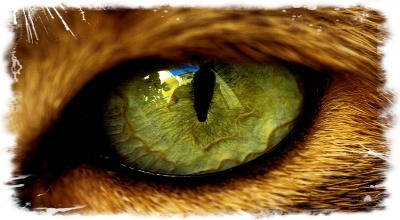
- mechanical injuries;
- allergies;
- Contact of foreign objects with the mucous membrane of the eye;
- conjunctivitis;
- glaucoma, cataracts;
- changes in the position of the eyelid;
- Infectious, viral disease;
- tumor.
Trauma
Traumatic eye swelling can be seen in active cats after another unsuccessful acrobatic act or after a playful fight with a fellow cat. It is very common for adult kittens to get pawed in the eye by older companions when they play around. Cats are intelligent animals who know how to calculate force. Don't worry, if the swelling and redness is small, the eye will recover over time.
Cold compresses can make the recovery easier. Add foods to your cat's menu that contain vitamin A. It helps speed up regenerative processes.
Watch for changes: if the cat begins to secrete fluid profusely and the swelling continues to enlarge, go to the veterinary clinic immediately. These symptoms are seen when the cornea is damaged. Without timely intervention, it leads to partial loss of vision.
Causes and related symptoms
Damage
Swollen eye in cats is often seen as a result of a fall from a height or a fight. Such injuries can be superficial, through and through, or deep. If trauma has occurred, swelling is noticeable, the visual organ is tearful, inflamed. Bleeding is also possible. Swelling of the eye may also be provoked by a foreign object getting into it. If this is suspected, the owner needs a flashlight and a magnifying glass to examine the eyeball. Sometimes you can remove the object yourself, using tweezers. It is important not to forget that it must be sterilized beforehand.
However, it is better not to try to cope with the problem yourself and take the cat to the veterinary clinic.
Keratitis in pets

When the eyelid is swollen, inflammation of the cornea can be the cause of this condition. As the disease progresses, it becomes matted and cloudy. Fluid accumulates inside the cornea, which leads to swelling. The inflamed visual organ becomes pusy, teary and clumpy. The cat suffers from photophobia. If these symptoms are noticed, it is important to take the pet to the veterinarian without fail, as it is problematic to treat keratitis.
Third eyelid prolapse
A white film is located near the inner corner of the eye and serves a protective function. A prolapse of the blinking membrane provokes the following symptoms:
- uncontrolled closing and twitching of the eyelids;
- increased lacrimation;
- reddening of the mucous membranes;
- secretion of pus;
- crusting at the inner corners of the optic corners;
- puffy eyelids;
- bags under the eyes.
Eyelid puffiness
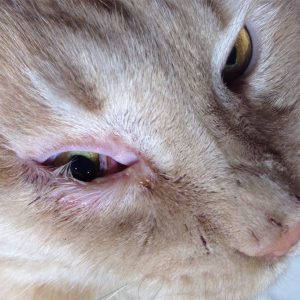
How to treat?
When a cat has swollen eye organs and bumps above the eye, it is important to show him to the veterinarian. Self-treatment can cause serious damage to the pet's health. The therapy regimen is selected by the veterinarian depending on what disease has been diagnosed. If the problem is minor and the swelling is due to inflammation of the mucous membrane, it is recommended to resort to the help of a weak solution of hydrogen peroxide. You need to dip a cotton swab in the liquid and gently wipe the cat's eyelids.
You can treat the cat with a solution of "Furacilin". Herbs will also help, for example, sage and chamomile. They have a bactericidal effect, help relieve swelling and arrest inflammation. If the cat is quiet, veterinarians from the "Zovet" clinic recommend using a cold compress. It should be applied to the affected organ, which will eliminate pain and swelling.
Twisted eyelid
Twisted eyelid, or entropion, is a pathological condition accompanied by the wrapping of the upper or lower eyelid inward, toward the eyeball. This phenomenon can be caused by hereditary, acquired or age factors.

At the beginning of the development of the pathological process, the pet begins to blink frequently due to drying of the eye. He has photophobia and small tears. The pain is moderate, and the animal prefers to hide in dark places.
As the disease progresses, the symptoms become more pronounced:
Read also: A cat has a dense and bloated abdomen: causes, associated symptoms, diagnosis and treatment
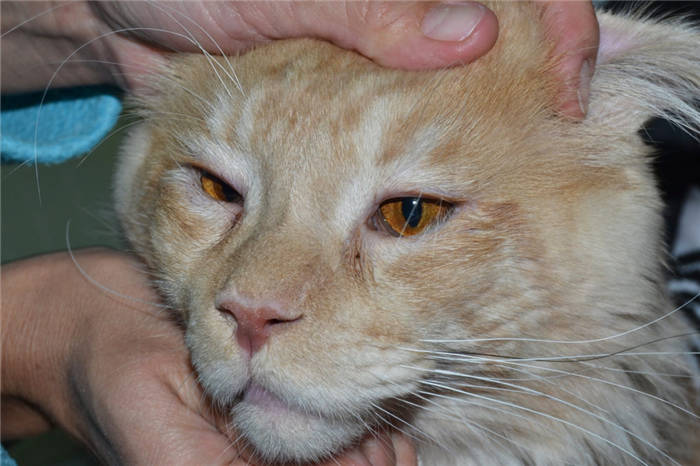
In the neglected form of eyelid entropion is accompanied by atrophy of the cornea and the inability to open the eye. Treatment tactics for entropion is determined by the veterinarian based on the results of diagnostic tests. This disease is treated conservatively (antibiotics, antimycotics, antiviral agents) or surgically (eyelid plasty).
Internal pathologies that cause swelling
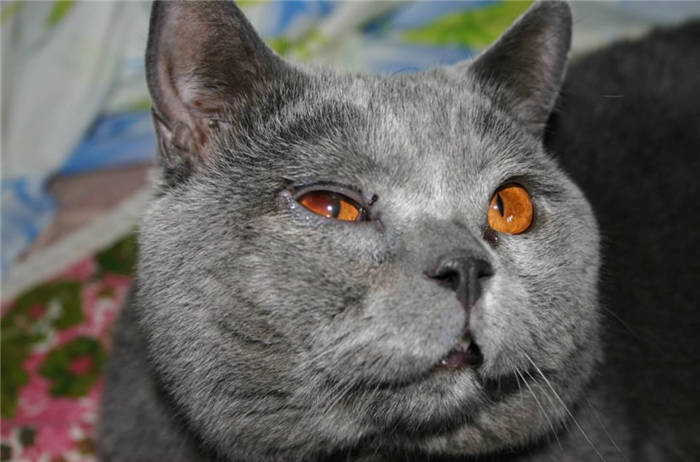
Swelling of the eyes in kittens or adult animals can also provoke disorders of internal organs:

What to do in this situation? The only reasonable solution for swollen eyes in a four-legged pet, especially if it has other pathological manifestations (for example, digestive disorders, weakness, lack of appetite), – as soon as possible to show it to the vet. At home it is impossible to determine the exact cause of this phenomenon. If you try to eliminate only its consequence, you will never be able to cope with the problem.
Eye swelling in a cat as a symptom of a serious disease
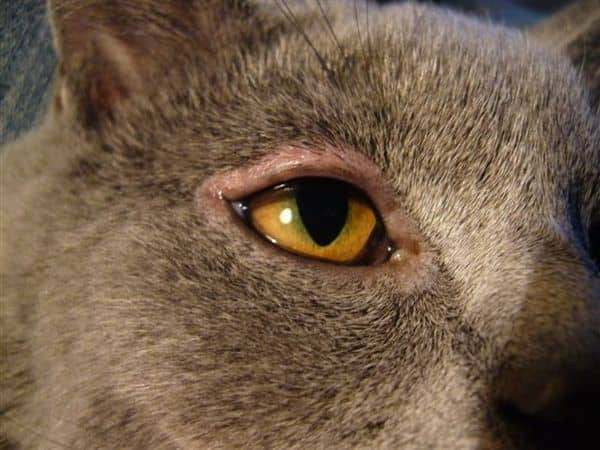
How do you know that a cat should be seen by an ophthalmologist immediately? Many serious diseases are made apparent by puffy eyes.
In uveitis, among other symptoms, corneal swelling is evident and the pupils are narrowed. The disease can be sudden and the cat will lose its vision if it is not treated in time. Blepharitis (inflammation of the eyelid on the eye) can develop in autoimmune pathologies or as a result of a worm infestation. Swelling under the eye in a cat may signal an ascending infection or the presence of a foreign body in the oral cavity.
Eye swelling in a cat: what to do?
Can you identify the condition on your own and know what to treat your cat with? No. And even a veterinary forum won't help you with this. Without a full-fledged special ophthalmological diagnosis it is impossible. As you can see, eye swelling is a symptom of many diseases, many of which can lead not only to loss of vision, but also to the death of your pet. Treatment at home is strictly by doctor's prescription. Don't waste time trying medications at random – see your pet to a specialist.
The medicine should always be prescribed by a doctor. Purulent blepharitis conjunctivitis and allergic puffiness are treated differently. And sometimes a comprehensive approach is required if the swollen eye is a symptom of diseases of the cardiovascular or endocrine system. The highly qualified specialists of Dr. Shilkin's Veterinary Ophthalmology Center will fully examine your cat's eyes at the very first consultation and prescribe an effective treatment.
What veterinary ophthalmology services to choose if your cat has puffy eyes
When you first come to our center, we recommend choosing the "All-Inclusive" service. The package allows for a comprehensive examination: anterior segment biomicroscopy, intraocular pressure measurement, pupil dilation, ocular fundus examination, eye ultrasound, consultation with veterinary ophthalmologists and savings. Also included is a diagnosis and treatment appointment.
When you choose a package, you know right from the start how much it will cost to see a specialist. We don't charge extra!
Reviews of A.G. Shilkin Veterinary Ophthalmology Clinic

In November 2020 we came to the clinic with our cat, Shurochka, both her eyes were swollen with cataract. She had already had an operation on one eye and was preparing for the next one. We would like to ask for help again to our nice doctors who are always friendly and attentive, as well as top class professionals. We wish you great achievements, happiness and prosperity.

Very pleased – meeting with you – and perhaps rightly so, they say – what God does – all for the best. including the fact that every time – you do a miracle! Our fate may be similar in some ways – but it is also unique. Since 5 years ago, our Kuzya died – and suddenly in December 2018, only once saw on the Internet one photo – and immediately decided – Take. ) She "noblewoman" lived in some office and the girls there posted a photo – and now (after 2 days shelter) Kuzya we have). In the December photo you can see a little bit the then state of the eye with the constant, gradually increasing tearing. Unfortunately – there are still loners appropriating the title of veterinary ophthalmologist. and we made attempts with them to cure our Kuzya (the girl. since we kept the name of her predecessor). But to no avail. And here we were lucky to meet her – Maria Alexandrovna . A clear diagnosis. Professional and patient treatment – for 3 weeks, as the lacrimal duct was inflamed and clogged. It has been a week since the last appointment – and Kuzi's eyes are calm. The canal is silent. and we have tears of joy in our eyes. Once again – a big THANK YOU – and wish Maria Alexandrovna further creative successes, patience and of course – preservation and strengthening of Health. THANK YOU





